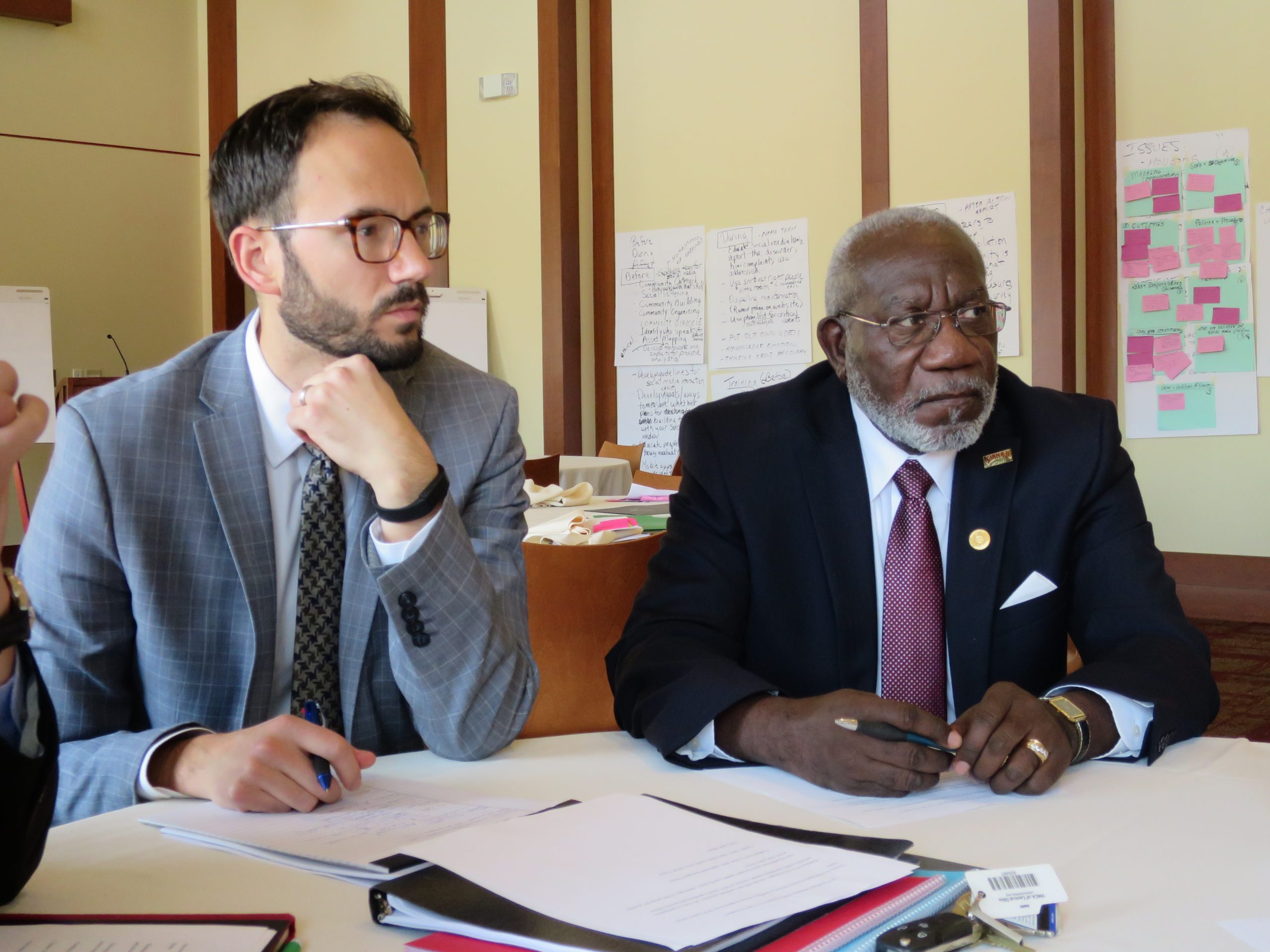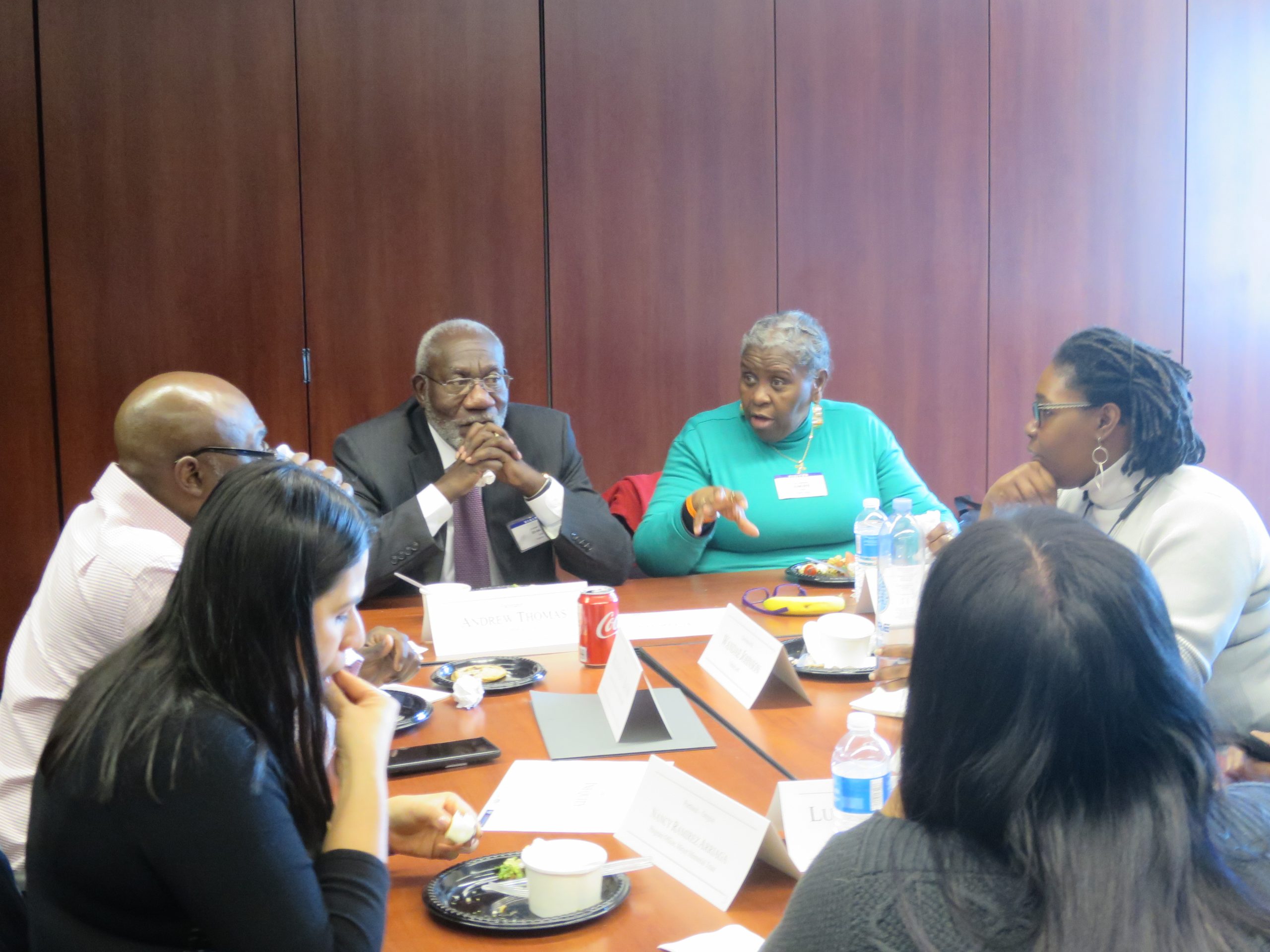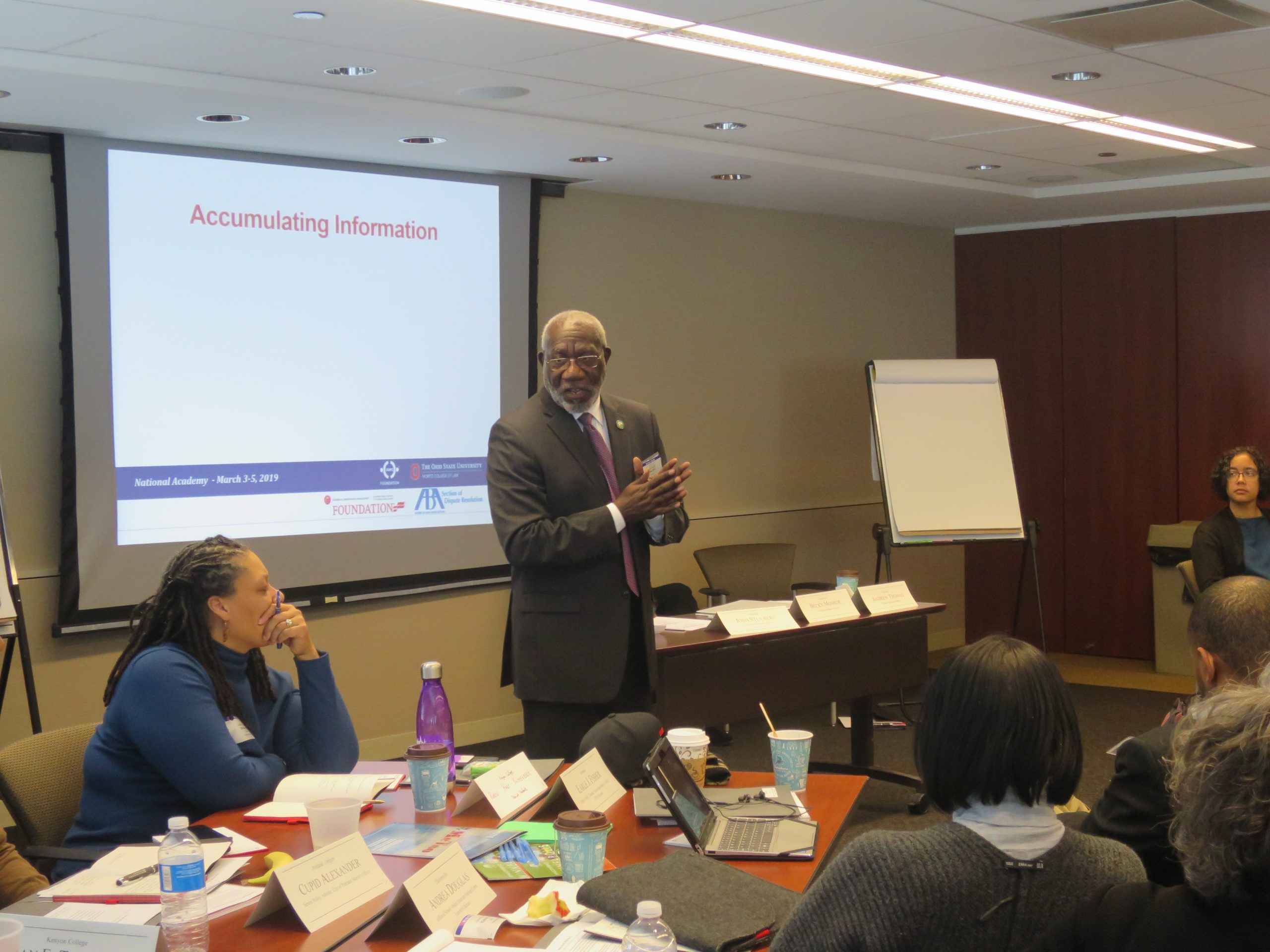By William Froehlich, Nancy Rogers, Carl Smallwood, and Josh Stulberg
Many communities struggle to respond constructively and creatively in the aftermath of a racially charged shooting and killing of an unarmed youth; that challenge is intensified when operating under the harsh lights of national media attention and facing waves of outside protesters calling for justice. In Sanford, Florida, a lakeside resort community near Orlando, a single mediator, Andrew Thomas, worked behind the scenes with civic leaders, residents, and demonstrators immediately following Trayvon Martin’s shooting death in 2012. Embedded within Sanford’s city infrastructure’s initiative to stimulate constructive dialogue and engagement with community stakeholders, he developed initiatives that helped local leaders mobilize others at critical moments to transform potentially destructive energy into progress for a community.
We can all learn from Andrew Thomas’ example. As Kenneth Bentley, a local school administrator said of the difference Thomas made in Sanford, Florida over the last decade:
“Every city in America needs an Andrew Thomas.”
The story does not begin with the City of Sanford simply hiring a mediator. In 2004, Thomas moved to central Florida, having retired from his serving as the Executive Director of the Center for the Settlement of Disputes (a community mediation center serving multiple counties centered in Rochester, New York). He began working with the Sanford Police Department as a consultant in 2008 with a focus on enhancing equity and diversity within the department as well improving the relationship between the Sanford Police and minority communities. In 2010 Thomas took on a position with the City of Sanford administering HUD Community Development Block Grants Program—not as the city’s ombudsman, or community mediator.
In February 2012, George Zimmerman, a neighborhood watch volunteer, shot and killed Trayvon Martin, a Black teenager, who was walking back from a Sanford store to his father’s residence. The killing and delay in arresting or charging Zimmerman became national news. Within days, tens of thousands of people flocked to Sanford, a community of 55,000, to protest and demand change. The results could have simply devolved into one more tragic story involving citizen complaints about law enforcement, a militarized police response, mass protests, property vandalism, citizen arrests – and no meaningful change.
But that did not occur in Sanford. Despite thousands of demonstrators, not one was hurt. No demonstrators were arrested; none was charged with a crime. There was little property damage. And, of deep significance, the energy generated by the crisis was channeled into a decade of progress and improved relationships across racial and other societal fault lines in Sanford.
We asked Andrew Thomas’ fellow residents in Sanford, Florida, to describe the difference he made over the last decade. They told us that, but for Thomas’ contributions, things might have gone notably differently.

Bill Froehlich and Andrew Thomas at a Divided Community Project event in Columbus in 2016.
Though it was not Andrew Thomas’ job then to act as a mediator or to offer suggestions for supporting the community as it grieved Trayvon’s death, he did it anyway. As an experienced community mediator, Thomas knew Sanford was under the microscope, and the city officials would need help. He recognized that the decision to prosecute the shooter would not quiet the furor that started when there was initially no arrest; rather, Thomas understood that the demonstrations would become a vehicle for raising other deep longstanding concerns festering in the Sanford community.
First, Thomas played a key role in expanding the number of mediators working in Sanford from one (himself) to ten. He did this by arranging for city officials to speak with their counterparts in other communities that had faced comparable situations in order to learn effective practices for addressing these dynamics. And a key message received was to secure assistance from the U.S. Department of Justice’s mediation arm, the Community Relations Service (CRS). Thomas helped them do so. According to Sanford City Manager Norton Bonaparte “Andrew was the key, instrumental person [who brought] in the Department of Justice.”
Within hours of Thomas’ call to CRS, federal mediators began traveling to Sanford from around the nation and worked to de-escalate volatile emotions, put in place trusted communications approaches, and get people talking.

Andrew Thomas seated with participants at a Divided Community Project program in Chicago in March 2019.
In addition, aware of the power of example, Thomas modeled the welcoming and respectful attitude toward protestors that invited the same attitude in return. Bonaparte stated that Thomas was the point person for facilitating conversation between city leaders and angry, impatient Sanford residents and community groups. As Grande Lum, then Director of CRS, reported in America’s Peacemakers, his book co-authored with Bertram Levine, Thomas successfully encouraged the city to rent a jumbotron screen so that protestors who would not fit into the Sanford City Commission Chambers could see and hear what was happening during city commission meetings and even provided transportation during rallies with rented golf carts for physically challenged demonstrators to reach their counterparts.
Bonaparte reflected on Thomas’s work with the Dream Defenders – student activists who marched 40 miles from Daytona Beach to Sanford – an event that was particularly illustrative of the value of Thomas’ contribution to the Sanford community. Shortly after they arrived in Sanford, several Dream Defenders “locked arms and began praying, sitting in front of police headquarters, preventing the public from getting in or out. They wanted [the city] to arrest them. You can see headlines: ‘Sanford arrests praying students; refuses to arrest man who killed Trayvon.’”
Bonaparte explained that the Dream Defenders articulated four demands: Fire the police chief; relieve the city manager; arrest Zimmerman; and guarantee nothing like this will happen again in the city. According to Bonaparte, Thomas was “central to negotiations” with the Dream Defenders, which ultimately led the city to host a public meeting, establish a blue-ribbon commission, and develop a nine-point plan for the City of Sanford.
According to Bonaparte, Thomas also led the process to “come up with the nine-point plan” for the City of Sanford titled One City – Many Communities which included working with the city commission to explore and develop the following components: 1) a request to DOJ to conduct a civil rights pattern and practice investigation; 2) the creation of a human relations commission; 3) the creation of a human relations commission staff; 4) the creation of a Police-Community Relations Blue Ribbon Commission; 5) the creation of an Inter-Racial Interfaith Alliance; 6) the creation of an anti-violence campaign; 7) the re-activation of the Sanford Neighborhood Action Plan; 8) a request for continued support from the Community Relations Service; and 9) and increase in youth training and employment opportunities.
Reflecting on the nine-point plan and a decade of work implementing the vast majority of the plan, Thomas explained that the plan “was a new beginning for the city,” and the “cornerstone of revamping the relationship between police, city hall, and the community.” Some were pessimistic about whether the Blue Ribbon Commission’s recommendations would be implemented. In fact, Thomas noted that many said the city was not committed to the recommendations, fearing that nothing would change. But, he pointed out, the construction of this commission was different.
The commission included a diverse group of stakeholders who had not previously worked with one another, and strong co-chairs (a Black minister, and a white retired county court judge). Thomas said that the commission’s recommendations were implemented and served as the foundation for improved police community relations for hiring Police Chief Cecil Smith. Its plan contained an intentional review of historic harm and damage in minority communities.
With the plan’s implementation, Thomas observed a “diminished tension between city hall and the community, increased voice and inclusion of the community in decision-making processes, and enhanced connection of disparate community groups.” Pointing to concrete outcomes Thomas explained the Department of Housing and Urban Development approved two years of funding to support the development of the “Goldsboro Transformation Plan,” a collaboration between the community, city, and housing authority to transform Goldsboro, the most economically distressed neighborhood in Sanford and “ground zero” for protests and rallies following the death of Trayvon Martin.

Andrew Thomas facilitating conversation at a Divided Community Project program in Chicago in March 2019.
Other residents noted that Thomas brought people together and facilitated their establishing new working relationships that helped the community through the crisis and persist in working jointly beyond it. Thomas explained that Sanford succeeded in “keeping violence to a minimum because of partnerships between city hall and the Black community. Despite longstanding tension between the Black community and Sanford Police, leaders from both communities worked exceptionally hard to protect the city and keep residents safe.” Thomas recalled: “Community leaders worked the streets around the clock to keep incidents from erupting and becoming a flashpoint for violence.” When something was brewing Thomas would get a phone call, he explained “Some in our community worked through the night – they would be out creating safe space for the disgruntled to sit and talk through what they were feeling.”
Sanford Pastor John Murphy spoke of Thomas’ role as a peacemaker. “Through his strenuous efforts to help bring solution to a city torn, he helped turn the tide to what could have been a disaster,” he said. “Andrew was a bridge over troubled water, spanning the distance between government, community, and the church, to solidify and unify a city in distress.”
Noting that Sanford’s Black and white clergy leaders did not regularly meet together, Thomas organized the first joint meetings of clergy from throughout Sanford. To maintain their work, he encouraged able people like Pastor Valarie Houston to assume leadership positions. The combined clergy group developed communication streams during the Zimmerman trial, taking turns attending the trial and giving out accurate information.
These clergy remained engaged after the initial crisis passed and the Community Relation Service mediators had left the city. At that point, Pastor Houston explained, “I organized CCC (Clergy-City-Community) to reinforce what was decided and needed in the African American Community.”
Equally important, Thomas made sure that people understood each other so that they could work together constructively. Rick Myers, who became Sanford’s Interim Police Chief following Trayvon’s death, recalled: “From the minute I arrived in Sanford, Andrew was welcoming and provided me with tremendous background information on Sanford’s history, including institutional racism, that impacted significantly my role as Interim Police Chief. Andrew is a strategic thinker, and I often bounced ideas and strategies past him.” He was “often pointing out areas where city departments were overlooking the needs of disenfranchised members of the community.”
As the energy from the protests was channeled into improving the community, the City of Sanford, recognizing the effectiveness of Thomas’ role and engagement, appointed him as Director of Community Relations and Neighborhood Engagement. Bonaparte explained that Thomas’ new title reflected his actual role in the community: “His role is so undefined and inclusive – anything happens community-wise, you go to Mr. Thomas. Community groups know Mr. Thomas. The importance of Mr. Thomas’s role is having a staff person whose function is getting out there, getting to know the grass roots of the community, and for the community to know them. So, if something happens, he is the reputable conduit of information to city hall as well as a conduit from city hall.”
Offering another illustration of Thomas’ collaborative and creative work with the community, Bonaparte described a phone call from a non-resident requesting to paint Black Lives Matter on a city street right outside the police station. At the same time, Bonaparte received a second request: “If you allow them to paint ‘Black Lives Matter’ on that street, there’s something I’d like to paint on another street.” According to Bonaparte, “through Mr. Thomas’s facilitation” the stakeholders agreed not to paint a city street, but to instead work with the city to further demonstrate the city’s commitment to diversity and inclusion.
One path to address this conflict might have been to work with the city’s art commission, but Thomas worked with stakeholders to take a broader, more inclusive approach, while working with the city to create, recruit, establish and facilitate Sanford’s Race, Equality, Equity, and Inclusion Advisory Committee. According to the city’s website, in 2021, the advisory committee was charged with “Institutionalizing equity and inclusion into the culture of the City of Sanford as an organization and the community at large; and establishing the foundation for a Diversity, Equity and Inclusion (DEI) initiative within the City of Sanford.” According to Thomas, in the summer of 2022, the committee submitted their draft report to the city commission for approval and adoption. The recommendations include a “Path to Reconciliation,” a series of kiosks within Fort Mellon Park (where demonstrations connected to Trayvon Martin’s death took place) that chronicle the 44 days between Trayvon’s death and George Zimmerman’s arrest, coupled with illustrations of what has occurred in Sanford over the past decade.
Before his retirement, people in Sanford had become accustomed to working with Thomas. Pastor Meghan Killingsworth said they thought of him as “an advocate for doing what’s right,” “a practitioner of doing good by bringing everyone along with him.” She added, “When he is in the room, everyone’s blood pressure goes down 10 points.”
The result was that people who had not previously engaged with the city began asking for Thomas’ help. Pastor Killingsworth explained, “When there is a crisis, they call Mr. Thomas. When an injustice is brought to the city, seeking a solution, they call Mr. Thomas. When someone has big dreams but needs a pathway for implementing them, they call Mr. Thomas. He builds bridges and helps ensure work isn’t duplicated. And he does it all with a heart of peace.” Chief Myers said, “Andrew has earned limitless respect from so many, because he always acts with deep respect for others.”
Sanford businessman Melvin Philpot pointed out that Thomas’ help in bringing people together and facilitating their organization had enabled the work of others to build a strong foundation for constructive multi-year initiatives in Sanford. Thomas helped to re-organize a housing authority and re-establish relationships that resulted in developing “150 new affordable homes that local residents now call home.” He established relationships with potential funders that kept “open the doors” for the Rescue Outreach Mission of Central Florida. Thomas aided organizers to establish the Martin Luther King Jr. Celebration Steering Committee “with the goal of keeping Dr. King’s vision alive in our community.”
Those we interviewed who experienced the “Andrew Thomas difference” in Sanford wish the same for other communities. In fact, Valencia College Peace and Justice Institute Director Rachel C. Allen, noted that neighboring Orlando borrowed Thomas in 2015 “when the City of Orlando reeled from charges of excessive use of force against Black residents by police.” Indeed, upon Thomas’s retirement from Sanford this summer, the metropolitan newspaper Orlando Sentinel headline read, in part, “Man who helped improve Sanford race relations retires.”
Andrew Thomas’ mediation background and practice is deeply rooted in dispute resolution and social justice principles—it made him a trusted, creative problem solver perfect for the current moment. Irrespective of job title, Pastor Philpot gave a job description for another community seeking to hire their Andrew Thomas – a list that community-wide mediators strive to embody – “integrity, honesty, commitment, selflessness, love for community, and desire to give back to the community without recognition.” City Manager Bonaparte added:
“You really can’t replace Mr. Thomas… you can fill the position, but you cannot replace Mr. Thomas.”
The authors are members, along with Andrew Thomas, of the Executive Committee of the Divided Community Project, part of the Program on Dispute Resolution at the Ohio State University Moritz College of Law, https://go.osu.edu/dcp. Carl Smallwood is the director and Bill Froehlich is the deputy director of the project. Josh Stulberg and Nancy Rogers are emeritus faculty of the Moritz College of Law.



